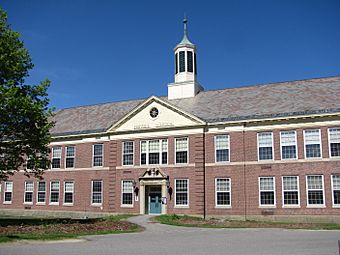Kittery Community Center facts for kids
Quick facts for kids |
|
|
Frank C. Frisbee Elementary School
|
|
 |
|
| Location | 120 Rogers Rd. Kittery, Maine |
|---|---|
| Area | 12.64 acres (5.12 ha) |
| Built | 1943 |
| Architect | Wells, Hudson & Granger |
| NRHP reference No. | 12000229 |
| Added to NRHP | April 25, 2012 |
The Kittery Community Center is a lively place in Kittery, Maine. It used to be the Frank C. Frisbee Elementary School. This building was special because it was built in 1943 by the United States government. It helped families during World War II when many people moved to work at the Portsmouth Naval Shipyard. The building is now a historic landmark, listed on the National Register of Historic Places since 2015. Today, it's a busy spot for arts, culture, and sports activities for everyone in Kittery!
Contents
The Kittery Community Center: From School to Fun Hub
The Kittery Community Center is located at 120 Rogers Road. It sits on the east side of Rogers Road, near Spruce Creek. The center is surrounded by green athletic fields and peaceful woodlands. You can even find a network of trails for walking or exploring.
A Look at the Building's Design
The building itself is quite long and has several parts. The oldest section was built in 1941. It has a sloped roof with a small tower called a cupola. The original main entrance is in the middle of this section. It has special decorations around it, like columns and a triangular top.
In 1943, a gymnasium and auditorium were added. This part is now connected to what serves as the main entrance for the Community Center. Later, in 1951, another section called the Annex was built. This addition actually doubled the size of the school!
Why Was This School Built?
The Frank C. Frisbee School was built in 1941. This happened because of a special program called the federal War Public Works. World War II was happening, and the government needed more workers. Many people were coming to work at the Portsmouth Naval Shipyard. This shipyard is located on islands in the Piscataqua River, near Kittery.
To help these new families, the government built the school. It also built new homes nearby, like the Admiralty Village development. The school belonged to the federal government until 1948. However, the town of Kittery ran it as part of their school system.
From School Days to Community Fun
After the Cold War ended, there was less activity at the shipyard. This meant fewer people lived in the area. Because of this, the town decided to close the school in 2009.
But the story didn't end there! Between 2011 and 2012, the building was changed. It became the Kittery Community Center. Now, it's a place where people of all ages can gather. They can enjoy art, learn about culture, and take part in many fun activities. It's a great example of how an old building can get a new life!



